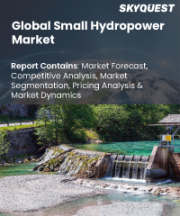
세계의 수력발전 시장 규모는 2023년에 2,561억 달러에 달하며, 예측 기간(2025-2032년)의 CAGR은 5.5%로, 2024년 2,701억 9,000만 달러에서 2032년에는 4,146억 5,000만 달러로 성장할 전망입니다.
세계 수력발전 시장은 지속가능한 에너지와 탈탄소화에 대한 관심이 높아지면서 큰 모멘텀을 보이고 있습니다. 각국은 화석연료에 대한 의존도를 낮추고 넷제로 목표를 달성하기 위해 재생에너지로의 전환을 추진하고 있으며, 수력발전은 계통 안정화를 위한 신뢰성과 확장성이 높은 솔루션으로 자리매김하고 있습니다. 개발도상국에서는 환경에 미치는 영향을 최소화하면서 증가하는 에너지 수요에 대응하기 위해 크고 작은 수력발전 프로젝트를 적극적으로 추진하고 있습니다. 에너지 전환 노력과 수력발전에 대한 투자가 이렇게 연결되는 것은 정부와 전력회사가 저배출 베스스로드 발전을 우선시하고 있으므로 시장이 긍정적으로 성장하고 있다는 것을 보여줍니다. 전 세계에서 프로젝트 승인을 강화하고 민관 파트너십을 촉진하는 유리한 정책 구상이 부상함에 따라 개발자들은 규제상의 이점과 안정성을 위해 수력발전을 채택하고 국가의 지속가능성 및 에너지 안보 구상을 지원하는 역할을 강화하고 있습니다.
Global Hydropower Market size was valued at USD 256.1 billion in 2023 and is poised to grow from USD 270.19 billion in 2024 to USD 414.65 billion by 2032, growing at a CAGR of 5.5% during the forecast period (2025-2032).
The global hydropower market is experiencing significant momentum due to the rising emphasis on sustainable energy and decarbonization. Nations are transitioning to renewable energy sources to reduce fossil fuel dependency and achieve net-zero objectives, positioning hydropower as a reliable and scalable solution for grid stability. Developing regions are actively pursuing both large- and small-scale hydro projects to meet increasing energy demands while minimizing environmental impact. This connection between energy transition efforts and hydropower investment underscores positive market growth, as governments and utilities prioritize low-emission baseload generation. Favorable policy initiatives are emerging globally, enhancing project approvals and promoting public-private partnerships, leading developers to embrace hydropower for regulatory benefits and stability, reinforcing its role in supporting national sustainability and energy security initiatives.
Top-down and bottom-up approaches were used to estimate and validate the size of the Global Hydropower market and to estimate the size of various other dependent submarkets. The research methodology used to estimate the market size includes the following details: The key players in the market were identified through secondary research, and their market shares in the respective regions were determined through primary and secondary research. This entire procedure includes the study of the annual and financial reports of the top market players and extensive interviews for key insights from industry leaders such as CEOs, VPs, directors, and marketing executives. All percentage shares split, and breakdowns were determined using secondary sources and verified through Primary sources. All possible parameters that affect the markets covered in this research study have been accounted for, viewed in extensive detail, verified through primary research, and analyzed to get the final quantitative and qualitative data.
Global Hydropower Market Segments Analysis
Global Hydropower Market is segmented by Type, Capacity, Component, End-User and region. Based on Type, the market is segmented into Mini Hydropower and Micro Hydropower. Based on Capacity, the market is segmented into Above 100 MW, Under 10 MW and Others. Based on Component, the market is segmented into Civil Construction, Electromechanical Equipment, Electric, Power Infrastructure and Others. Based on End-User, the market is segmented into Industrial, Utility and Others. Based on region, the market is segmented into North America, Europe, Asia Pacific, Latin America and Middle East & Africa.
Driver of the Global Hydropower Market
The global focus on combating climate change and lowering carbon emissions has significantly fueled interest in hydropower as a viable energy source. Governments and utility companies are increasingly investing in hydropower projects, recognizing them as sustainable and dependable energy solutions. These initiatives play a crucial role in advancing the hydropower market while also contributing to long-term energy security. By prioritizing clean energy development, stakeholders are helping to foster a more sustainable energy landscape that meets the growing demands for eco-friendly resources while addressing the urgent need for efficient energy production.
Restraints in the Global Hydropower Market
The Global Hydropower market faces significant challenges due to the substantial initial investments needed for infrastructure development, alongside the complexities of regulatory approvals, permitting, and environmental compliance. These financial burdens can hinder the advancement of projects, especially in regions with constrained funding or insufficient supportive policies for private sector involvement. Consequently, these obstacles may lead to delays in project execution and restrict the engagement of private entities in hydropower initiatives, ultimately limiting the sector's growth potential and its ability to contribute to renewable energy goals. Addressing these constraints is vital for fostering a more robust hydropower landscape.
Market Trends of the Global Hydropower Market
The global hydropower market is witnessing a significant trend towards the integration of artificial intelligence (AI) and real-time threat detection systems, enhancing operational efficiency and risk management. These advancements enable hydropower facilities to proactively identify and mitigate potential cyber threats, thereby improving the resilience of energy infrastructures. Insurers are capitalizing on this trend by offering dynamic coverage that adapts to real-time insights, ultimately reducing the number of claims. Furthermore, AI-driven analytics facilitate better decision-making, optimizing resource allocation and operational performance. As the market evolves, the emphasis on technological innovation positions hydropower as a competitive and secure energy source in the renewable sector.